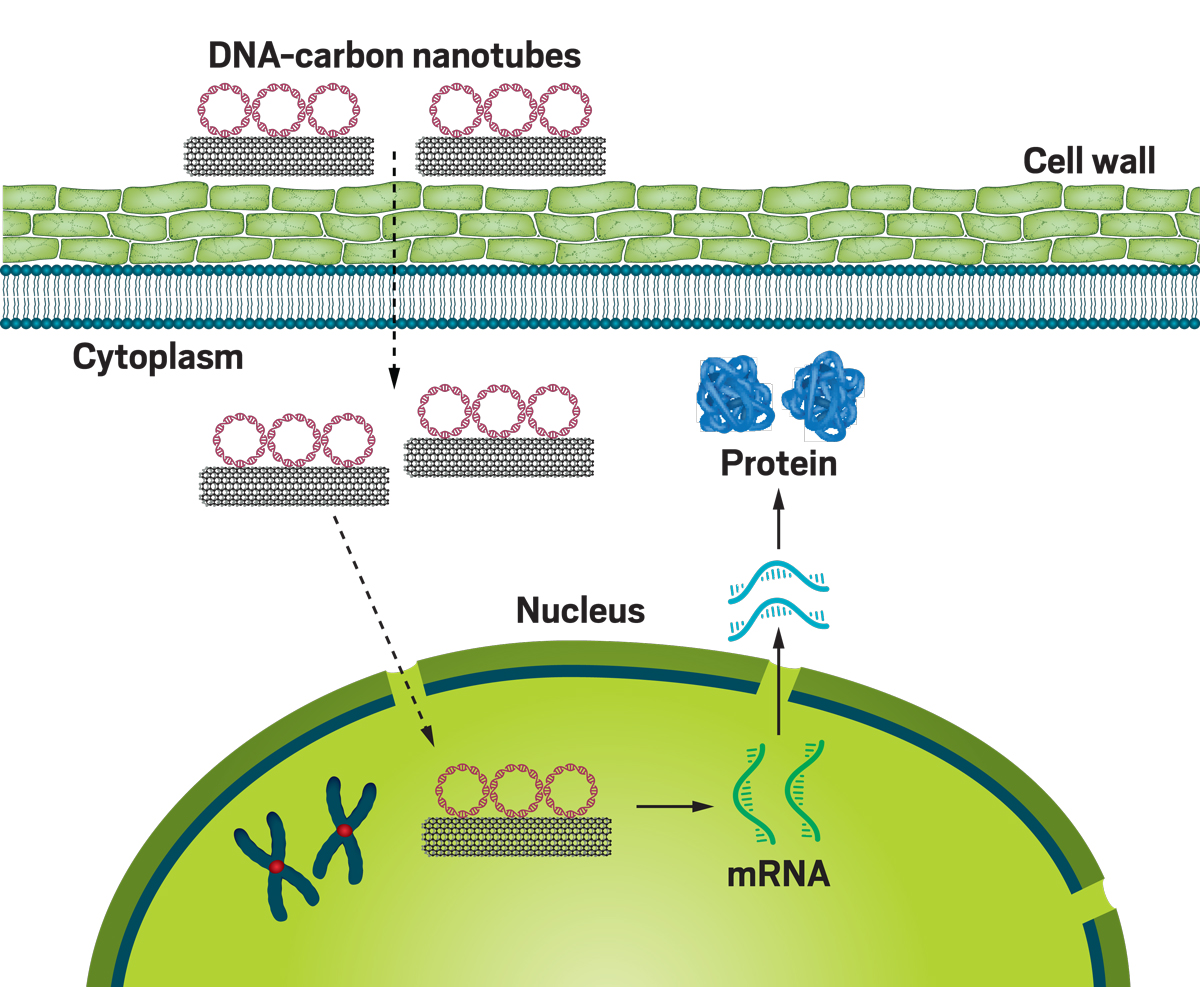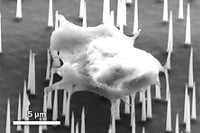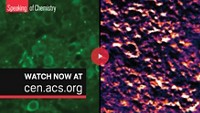Advertisement
Grab your lab coat. Let's get started
Welcome!
Welcome!
Create an account below to get 6 C&EN articles per month, receive newsletters and more - all free.
It seems this is your first time logging in online. Please enter the following information to continue.
As an ACS member you automatically get access to this site. All we need is few more details to create your reading experience.
Not you? Sign in with a different account.
Not you? Sign in with a different account.
ERROR 1
ERROR 1
ERROR 2
ERROR 2
ERROR 2
ERROR 2
ERROR 2
Password and Confirm password must match.
If you have an ACS member number, please enter it here so we can link this account to your membership. (optional)
ERROR 2
ACS values your privacy. By submitting your information, you are gaining access to C&EN and subscribing to our weekly newsletter. We use the information you provide to make your reading experience better, and we will never sell your data to third party members.
Nanomaterials
Amazing Women
Markita Landry
Nanomaterials whiz is developing tools to deliver DNA to plants and detect brain chemicals
by Celia Henry Arnaud
August 25, 2019
| A version of this story appeared in
Volume 97, Issue 33

Credit: Courtesy of Markita Landry/Shutterstock/C&EN

Vitals
Current affiliation: University of California, Berkeley
Age: 34
PhD alma mater: University of Illinois at Urbana-Champaign
Role model: “My mother is my scientific role model. As a telecommunications engineer, she was a leader in the field during the dot-com era and in bringing communications technologies wireless. I remember she had a beeper and was on call on New Year’s Eve during the whole Y2K scare, and remember thinking that no matter how computers mishandled the transition from ’99 to ’00, I wasn’t worried because I knew she’d be able to fix it!”
If I were an element, I would be: “Given that the past 5 years of my scientific career have been based on low-dimensional carbon-based nanotechnologies, it would be subversive for me to choose an element other than carbon!”
Must-have in the lab: “My giant whiteboard!”
Must-have on the road: “Sleep eyeshades.”
3 key papers
“Imaging Striatal Dopamine Release Using a Nongenetically Encoded Near Infrared Fluorescent Catecholamine Nanosensor” (Sci. Adv. 2019, DOI: 10.1126/sciadv.aaw3108)
“DNA Nanostructures Coordinate Gene Silencing in Mature Plants” (Proc. Natl. Acad. Sci. U.S.A. 2019, DOI: 10.1073/pnas.1818290116)
“High Aspect Ratio Nanomaterials Enable Delivery of Functional Genetic Material without DNA Integration in Mature Plants” (Nat. Nanotechnol. 2019, DOI: 10.1038/s41565-019-0382-5)
By using nanomaterials to create new tools, Markita Landry reckons she can crack open new areas of science. Landry, an assistant professor of chemical and biomolecular engineering at the University of California, Berkeley, is harnessing the chemical and physical properties of nanomaterials to do things like deliver DNA to plants and measure signaling molecules in the brain.
In the plant work, her group uses nanomaterials, such as carbon nanotubes, to ferry DNA into plant cells. The new DNA prompts the plants to churn out proteins that can give them new traits, such as drought or pest resistance.
Plants have been notoriously difficult to manipulate using conventional gene-editing approaches, such as CRISPR-Cas9. “One of the things I was most surprised by is how many of the tools that work really nicely for bacterial systems, yeast systems, and even mammalian cells fail in plants because of the cell wall,” Landry says. “It’s quite difficult to get DNA in plants because the cell wall is a very rigid multilayer structure that excludes most molecules. By using nanomaterials, we can sneak past the cell wall,” she explains.
And delivering DNA via nanomaterials doesn’t permanently alter a plant’s genome, meaning the plant doesn’t pass on those new traits. Because Landry’s method doesn’t result in a genetically modified organism, it might be more appealing to consumers and regulators.
For her work with plants, Landry relies on the physical properties of the nanomaterials. For her neuroscience work, she’s making chemical modifications. By decorating the surface of carbon nanotubes with short strands of nucleic acids, her group has made nanosensors that fluoresce only in the presence of neurotransmitters such as dopamine or norepinephrine.
Those nanosensors offer a resolution that lets Landry measure the timing and location of neurotransmitters as they signal between neurons in the brain. With this information, she might be able to see how individual neurons respond to drugs. Landry is particularly interested in exploring how neurons in broad networks—such as those that release dopamine or other so-called neuromodulators—talk to one another. In those complicated networks, spatial information can be especially useful.
The new tools that Landry is developing are already generating buzz in plant science and neuroscience, says Michael S. Strano, a chemical engineering professor at the Massachusetts Institute of Technology and her postdoc adviser. When a researcher moves into a new field, it can typically take years to build up credibility and get noticed, he says. “The quick way around that is to produce a paper that people find compelling. This has happened to Markita in her work on plants and also in neuroscience.”
Landry says she chose to go to UC Berkeley because of its strengths in many different areas of science. She is already cultivating collaborations to advance applications of her technologies. “Now that we’ve validated our platforms, we’re putting them in the hands of other scientists and seeing what they do with them,” she says.
Advertisement
By using nanomaterials to create new tools, Markita Landry reckons she can crack open new areas of science. Landry, an assistant professor of chemical and biomolecular engineering at the University of California, Berkeley, is harnessing the chemical and physical properties of nanomaterials to do things like deliver DNA to plants and measure signaling molecules in the brain.
In the plant work, her group uses nanomaterials, such as carbon nanotubes, to ferry DNA into plant cells. The new DNA prompts the plants to churn out proteins that can give them new traits, such as drought or pest resistance.
Advertisement
Plants have been notoriously difficult to manipulate using conventional gene-editing approaches, such as CRISPR-Cas9. “One of the things I was most surprised by is how many of the tools that work really nicely for bacterial systems, yeast systems, and even mammalian cells fail in plants because of the cell wall,” Landry says. “It’s quite difficult to get DNA in plants because the cell wall is a very rigid multilayer structure that excludes most molecules. By using nanomaterials, we can sneak past the cell wall,” she explains.
And delivering DNA via nanomaterials doesn’t permanently alter a plant’s genome, meaning the plant doesn’t pass on those new traits. Because Landry’s method doesn’t result in a genetically modified organism, it might be more appealing to consumers and regulators.
For her work with plants, Landry relies on the physical properties of the nanomaterials. For her neuroscience work, she’s making chemical modifications. By decorating the surface of carbon nanotubes with short strands of nucleic acids, her group has made nanosensors that fluoresce only in the presence of neurotransmitters such as dopamine or norepinephrine.
Those nanosensors offer a resolution that lets Landry measure the timing and location of neurotransmitters as they signal between neurons in the brain. With this information, she might be able to see how individual neurons respond to drugs. Landry is particularly interested in exploring how neurons in broad networks—such as those that release dopamine or other so-called neuromodulators—talk to one another. In those complicated networks, spatial information can be especially useful.
The new tools that Landry is developing are already generating buzz in plant science and neuroscience, says Michael S. Strano, a chemical engineering professor at the Massachusetts Institute of Technology and her postdoc adviser. When a researcher moves into a new field, it can typically take years to build up credibility and get noticed, he says. “The quick way around that is to produce a paper that people find compelling. This has happened to Markita in her work on plants and also in neuroscience.”
Landry says she chose to go to UC Berkeley because of its strengths in many different areas of science. She is already cultivating collaborations to advance applications of her technologies. “Now that we’ve validated our platforms, we’re putting them in the hands of other scientists and seeing what they do with them,” she says.
Vitals
Current affiliation: University of California, Berkeley
Age: 34
PhD alma mater: University of Illinois at Urbana-Champaign
Role model: “My mother is my scientific role model. As a telecommunications engineer, she was a leader in the field during the dot-com era and in bringing communications technologies wireless. I remember she had a beeper and was on call on New Year’s Eve during the whole Y2K scare, and remember thinking that no matter how computers mishandled the transition from ’99 to ’00, I wasn’t worried because I knew she’d be able to fix it!”
If I were an element, I would be: “Given that the past 5 years of my scientific career have been based on low-dimensional carbon-based nanotechnologies, it would be subversive for me to choose an element other than carbon!”
Must-have in the lab: “My giant whiteboard!”
Must-have on the road: “Sleep eyeshades.”
Research at a glance

Credit: Adapted from Nat. Nanotechnol./Yang H. Ku/C&EN
Landry uses carbon nanotubes to shuttle DNA past the cell wall and into plants, where the DNA can be transcribed to make proteins the plant wouldn't otherwise produce.
Three key papers
“Imaging Striatal Dopamine Release Using a Nongenetically Encoded Near Infrared Fluorescent Catecholamine Nanosensor”
(Sci. Adv. 2019, DOI: 10.1126/sciadv.aaw3108)
“DNA Nanostructures Coordinate Gene Silencing in Mature Plants”
(Proc. Natl. Acad. Sci. U.S.A. 2019, DOI: 10.1073/pnas.1818290116)




















Join the conversation
Contact the reporter
Submit a Letter to the Editor for publication
Engage with us on Twitter